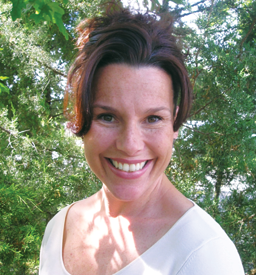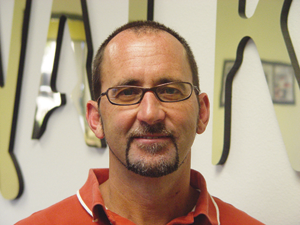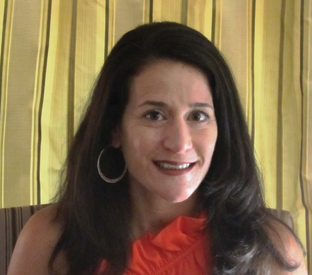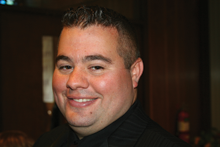Celebrating alumni entrepreneurs
Nine alumni tell how they made their entrepreneurial dreams come true and share tips for those looking to do the same.

Garry M. Keel (MEd) ’83
Company: Money Management Associates
Some people get a part-time job to pursue their passion. Garry Keel got a second career.

For 30 years, Keel has been working in higher education student services, a career he chose because he loves working with people.
But, at heart, Keel has always been a numbers guy, so in 1984 he founded Money Management Associates. His firm provides income tax preparation and financial planning servicesfor individuals and small businesses throughout the tri-state area.
It was this second career that Keel originally planned to pursue until he realized the solitary lifestyle it held in store.
“Back then, being an accountant meant you’d be on your own, in the corner crunching numbers,” he said. He found a new calling in academia, but didn’t lose his “love of working with numbers, debits, credits, and such.”
So in 1980 he took classes offered through a large tax firm, figuring that learning the tax code would help him maximize his own returns. The classes led to work with the company and, due to his background in education, Keel started teaching courses for the firm.
When family and friends started calling for tax advice, he decided to set out on his own.
Keel started Money Management Associates out of his garage with approximately 50 to 60 clients. Those 50 or 60 quickly turned into 100, which turned into 200, and these days Keel has more than 450 clients. He’s since moved the company moved out of his home and into an office building in Ewing, New Jersey, and now employs three staff members and a student intern from TCNJ’s accounting department.
Clients come to Keel for help with budget planning, mortgage decisions, social security tax issues, and advice on working with lump sum retirement account payouts, but tax work is his company’s “bread and butter,” he said.
“Between January 1 and Tax Day I have two full-time jobs,” Keel said, adding that it’s “gumption” that gets him through the long hours he puts in during tax season. Even after the seasonal rush ends, there is still work to be done with clients who filed extensions, as well as quarterly reporting and corporate tax work. But it’s nothing like the “rat race” that takes place between the first of the year and April 15, Keel said, adding he’s thankful his wife, Lenora Baker Keel ’80, understands the time demands his two careers entail.
“It’s interesting how you can start a career, leave, and then come back to it,” Keel said. “I really like working in higher education: I went to school to be an administrator, and I love what I do. But I also like the accounting side of things.” The field is much different now than 30 years ago: he’s not by himself in the corner crunching numbers, he explained. His second career affords him the opportunity to be part accountant and part educator, teaching clients about tax rules and budget planning.
“I’m just a good numbers guy who people trust to give them the right information and steer them in the right direction,” said Keel.
Janeen (Cranmer) Yodakis ’91
Company: Be A Duck
Be a Duck grew out of advice company owner Janeen Yodakis gave to her 7-year-old daughter Elizabeth, who came home from school one day complaining she was being picked on by classmates.

“I instinctively told her, ‘Hon, you need to be a duck. Let it roll off your back,” Yodakis recalled.
Her daughter heeded the advice, but Yodakis realized the solution wasn’t always that simple.
“There are so many children being bullied, harassed, and intimidated these days, so I decided to do something about it,” she said.
Yodakis, a former teacher, spent months researching the issue and developing lessons to teach Kindergartners about it. “Bullying and harassment begin at that age, and I wanted the program to be proactive, not reactive,” she explained.
The result is a six-session, interactive workshop that teaches children what their rights are, why to embrace their uniqueness, how to stand up to peer pressure, the consequences of bullying, the importance of respecting others’ personal space, and how to create a support system they can turn to when needed.
“People think children are too young to understand these things, but they’re not,” said Yodakis. “If you present the material using the correct language and in the correct format—which we do, using puppet shows, role playing, activities with Play-Doh—children get the message, embrace it, and connect with it.”
Yodakis presents her workshop “wherever there are organizations advocating for children,” she said. While Be A Duck is a for-profit company, Yodakis said she’s committed first and foremost to getting her message out. She sells DVDs of her workshop in an effort to make the program affordable to large school districts, and recently donated DVDs to a church doing mission work in Belize.
“I try to help communities that can’t afford—but desperately need—this message,” she said.
Like many business owners, Yodakis said she faced plenty of challenges in getting her company off the ground. She said the most important step she took, and one she advises any aspiring entrepreneur to take, was finding a mentor who helped her create a business plan.
“I’m a great teacher who had a great concept, but I didn’t know a thing about the business world when I started,” she said.
Yodakis, who is also a board member of The Ashley Lauren Foundation (a charity for children with cancer), added: “You know you have a good business when you’re living your life’s passion. Mine is helping children. Always has been, always will be.”
Ted Dardzinski ’86
Founder, Project Walk Spinal Cord Recovery
When his first foray into entrepreneurship dissolved (he co-owned a rehabilitation and training center), Ted Dardzinski was left with a 5,000 square-foot exercise facility, but no business. Then a former client asked him to help a friend who had been paralyzed in a car crash. Though he hadn’t worked with a spinal cord injury (SCI) client before, Dardzinski decided to help.
“We did everything against the books, and eventually the guy walked out the door on his own,” Dardzinski said.

Word spread quickly in the SCI community, “people in wheelchairs started showing up at our door,” and Dardzinski was soon hiring trainers to handle the demand. Project Walk Spinal Cord Recovery, the business, was born.
Over the ensuing 13 years, Dardzinski has developed and refined a revolutionary activity-based recovery program for SCI sufferers. The Dardzinski Method is a five-phase program that can be tailored to each client’s individual needs, and over the years 71 percent of the SCI sufferers he’s helped have seen improvements from the program, Dardzinski said.
“That doesn’t mean they all walk again, but it means that they improve [and shows that] spinal cord injuries can improve if they’re treated properly,” he said.
Project Walk started as a “mom and pop shop,” but has grown into a worldwide operation with an evolving business model, Dardzinski said. SCI patients still come to the company’s Carlsbad, California, headquarters for treatment, but Project Walk also now certifies therapists and healthcare professionals in Dardzinski’s method. In turn, those individuals are opening Project Walk centers around the globe.
“The business will eventually be more people coming here to learn the method than to seek treatment,” Dardzinski said, adding that the company is moving into a much larger facility with lecture halls and classrooms this fall.
Although Dardzinski created Project Walk as a for-profit company, he changed it to a nonprofit institute several years ago. The transition allows Project Walk to receive donations and grants to further its SCI research, but required Dardzinski to relinquish the title of owner. These days he serves on the board of directors, helping with long-term planning and furthering the educational side of the company.
“There was no such thing as exercise-based recovery for spinal cord injuries when I founded Project Walk,” Dardzinski said. “The industry didn’t exist. But today, The Dardzinski Method is becoming the standard treatment for spinal cord injuries throughout the world.”
Rose Marie (Niro) Iskowitz ’93
Company: RMI Enterprises (creator of Dipe n’ Go)
As a mother of two who was always on the go, Rose Marie Iskowitz found herself changing a lot of diapers in the back of her SUV—and noticed many other parents doing the same. When she discovered no product existed to make the process more sanitary and convenient, she created one herself. The Dipe n’ Go is an all-in-one portable changing station for SUVs and minivans. Made of machine washable fabric, it doubles as an organizer for spare diapers, wipes, and powder.

Taking her idea from that “a-ha” moment to having a product on store shelves was a three-year process that “involved many potential pitfalls along the way,” Iskowitz said. After conducting a patent search she hired a seamstress to create a prototype, then searched for a manufacturer. When she discovered producing Dipe n’ Go in the U.S. would push unit costs too high, she opted to manufacture in China. That required hiring a liaison to work with the Chinese company to make sure consumer product safety regulations were met.
When she received her first batch of inventory, Iskowitz connected with Babies-R-Us representatives at a Las Vegas trade show. The company put Dipe n’ Go in its stores in spring 2010, and other retailers soon followed suit. Since then, Iskowitz has licensed her product; she’s no longer involved with the manufacturing end, but retains the rights to to the product and receives royalties on all sales.
Although her story has a happy ending, Iskowitz admits she made a few missteps along the way, any one of which could have altered the outcome. She also realized that she had made a number of valuable business contacts during the process, from manufacturers, to people who make prototypes, to public relations professionals, to retailers, to companies looking to license baby products. Without another product idea of her own at that moment, she saw a new business opportunity. She started Jersey Girl Promotions (under the umbrella of RMI Enterprises) to help “mompreneurs” and “dadpreneurs” launch their products and place them in retail outlets. Though her latest venture just started a few months ago, she already has several clients.
“It looks like this is going to be a nice niche for me,” Iskowitz said.
Gregg Hollmann ’93
Company: Ambient DJ Service
Gregg Hollmann was an equity analyst in Manila when 1997’s Asian financial crisis sent world markets reeling and landed him back in the U.S., unemployed. He caught on with a business valuation firm, but while the pay was great he found the work unfulfilling.
“There’s some creativity involved with picking stocks. Business valuation is very quantitative; creativity is frowned upon,” he said.

Looking for a new creative outlet, he rediscovered his passion for music. A lifelong music lover—he had turned down a music scholarship to study finance—Hollmann had amassed an extensive, eclectic music collection over the years. He started DJing parties on the side. “Performing for a room full of strangers every weekend was a great outlet for that other side of my personality.” A few years later, he cashed in $15,000 in stocks, bought professional DJ equipment, and officially launched his business, Ambient DJ Service.
Since the industry is largely referral-based, Hollmann said his initial strategy for attracting clients was pricing below market rate. He also made a conscious decision early on not to follow the “old school way” of building a DJ business (appearing at bridal shows), concentrating instead on Internet marketing. He paid a professional to overhaul his website, then drove traffic there by dedicating a percentage of profits to advertising on wedding portals. Weddings now make up about half of the company’s sales dollars, with the rest coming from corporate and private parties, community events, and dances.
When he started earning more money DJing than from his first job, Hollmann quit the valuation firm and dedicated himself to the business. He now has six DJs working for him and is training two new employees.
His workweek is a little different. “My peak time is Friday through Sunday,” he said. “Mondays are my so-called weekends. Tuesdays through Thursdays, I’m prepping for upcoming events, selling new jobs, and training DJs.” Despite the odd hours, he’s enjoying it. “It doesn’t feel like work.”
Asked what he’d tell someone considering starting a business, Hollmann advised following your passion—but proceeding cautiously.
“I wouldn’t recommend anyone blindly jump into something on a whim,” Hollmann said. “I followed my passion, but did it part time at first to validate that I could make money. Thus far, it’s working out well.”
Sharon Wasko ’00
Company: Puppy Uprising Pet Sitters (P.U.P.S.) of West Philadelphia
Sharon Wasko was two years out of college, in between jobs and planning her next career move when a friend offered to pay her to walk his dog. A lifelong animal lover, Wasko agreed, then at the suggestion of another friend started advertising her dog-walking services in her neighborhood. “Things just blossomed from there,” Wasko said, and before she knew it she was running her own business.

These days, P.U.P.S. offers dog-walking, house sitting (for vacationing pet owners who can’t, or won’t, board their animals), and pet care services for just about any type of indoor pet. “I’d say 75 percent of my business is dogs, 24 percent cats, and the remaining one percent is your occasional rabbit, squirrel, or lizard,” Wasko said. She runs the company out of her home, which keeps overhead costs low—“I just need a computer to keep in touch with clients and a place to store their keys,” she said—and along the way has taught herself database management and financial software to track clients and finances.
Despite the recession, the pet-sitting business is booming she said, and a few years ago she hired two independent contractors to meet the demand.
Like many business owners, Wasko said one of the biggest challenges of being an owner is the 24/7 nature of the position. “I work seven days a week, and I’m constantly fielding calls and e-mails from clients,” she said. “It’s a challenge to get used to that, and I think that’s why many people who start their own business burn out.”
Had she to do it all over again, Wasko admits a little more planning might have helped. “I didn’t really start the business on purpose; it was probably a couple of years before I realized I was actually running a business,” she said with a laugh. “If I had actually sat down and game-planned better, I probably would have made more money from the start.”
Jared Klett ’99
Cofounder, blip.tv
Jared Klett and friends were working on a number of business ideas when they struck upon the concept for blip.tv, a consumer destination site for scripted, original Web series. By partnering with sponsors, blip.tv can offer viewers free access to a wide variety of shows, while providing advertisers with targeted audiences for brand promotion. The company then shares ad revenue equally with the series’ producers.

Like many new business owners, Klett said he played a number of roles in the company’s early stages. He filed the papers of incorporation to create Blip Networks, Inc. A computer science graduate, he wrote most of the code and built blip.tv’s networking infrastructure. He managed finances and operations, setting up the payroll system and reconciling accounts each month. It was all a little stressful and nerve-wracking at first, he admits. “We were seeing the ‘guts’ of running a business, which is hidden when you work for someone else.”
Klett said blip.tv was started with bootstrap funding. He opened the first corporate credit card under his own name. “If we had tanked my personal credit line would have taken a big hit,” he quipped. It didn’t. The company closed its first round of angel funding in 2006, which allowed Klett and the other founders to quit their day jobs and concentrate on blip.tv fulltime. In the ensuing years, the company has raised $18 million from investors.
The fundraising process can be “painful” at first, Klett said. “You have to look carefully at investors’ proposals and make some difficult decisions…but each round gets a little easier.” He credits his fellow cofounders with bringing in outside advisers who weren’t necessarily thinking about investing in the company; in exchange for advice they received common stock. “That proved to be invaluable,” Klett said.
Klett’s next-generation television network now hosts more than 300 million video views per month, and the company has about 70 employees working in six cities across the U.S., he said. This has enabled him to offload many of his earlier responsibilities and concentrate on software development. “That’s really what I enjoy doing.”
“As a company founder you’re responsible for other people’s livelihoods, and it can be stressful,” said Klett. “I’ve gotten better at managing that stress, and as we’ve grown the stress has obviously decreased. There’s certainly nothing like being your own boss, but it’s not for everyone.”
Matthew Robinson ’02 and William Parkhill ’03
Company: MidAtlantic Engineering Partners, LLC
What could motivate two senior-level associates at a well-established engineering firm to leave the stability of their positions and start their own company during one of the worst recessions and most-distressed construction markets in recent history?

“We saw a niche in the market,” said Matthew Robinson ’02, who together with William Parkhill ’03 and Louis Zuegner formed MidAtlantic Engineering Partners, LLC, in 2010. “The opportunity was driven by the fact that the market is so stressed right now.”
MidAtlantic provides site survey, engineering design, construction oversight, and entitlement management services to private and municipal clients in the tri-state region. It’s a small outfit—in addition to the principals there are six employees, including Design Engineer Kevin Shelly ’08 and Bill’s wife Sarah (nee Bates) ’03. But MidAtlantic caters to large-scale development projects, and in the past year has worked on a variety of projects including design and permitting for a new 35,000 square-foot medical office building, the expansion of a large petroleum tank farm, as well as several large apartment complexes for both affordable housing and market rate use.
It sounds paradoxical: that a stressed market could create opportunities for a startup firm in an industry long driven by existing relationships. But the recession forced builders to be thrifty, and since engineering services costs are often unfinanced—that is, builders spend their own money, up front—any savings that can be realized have become increasingly important to builders.
“That’s where we stepped in,” said Robinson. “We’re a small firm, but advances in AutoCAD® technology let us do the same job as the firm we left. We have an efficient, streamlined operation. Everyone in the building, from the principals down, works on each job…. and the fact that we can save clients money up front, they know us, and know we do good work” has allowed MidAtlantic to flourish despite the economy.

That direct involvement from everyone at the firm is a major advantage of working with MidAtlantic, Parkhill explained. “From the principals on down, we’re all accountable on every project. That’s something clients can’t get at the larger firms.” Added Robinson: “That direct access to the principals is important to our clients. They know they can pick up a phone and talk to [one of the owners] and [we’re] going to deal with their issue directly and give them a straight answer.”
Because they are so involved with every project that comes through the door, the day-to-day aspect of their work hasn’t changed much from their days working at the larger firm, Robinson and Parkhill agreed. But now they have a lot of other things to be concerned about: where the next client is coming from, which insurance provider to use, what health plans to offer employees…the list goes on and on.
“It’s not, ‘I’m the boss, I don’t have to do anything. It’s, ‘I’m the boss, I have to do twice as much,’” said Robinson. “The good and the bad of owning your own business is that the business becomes your life,” Parkhill concurred. “We’re not going to work at 8 and going home at 5 any more.”
Still, both said they couldn’t be happier that with the decision they made to set out on their own. Business has been going better than either of them had imagined it would, said Parkhill, and Robinson, while admitting that the decision was “one of the most difficult ones” he had ever made, said he’s “thrilled” that they “took the jump.”
“I can’t imagine going back to the role I was in before,” said Robinson, adding with a laugh, “I wish I had done this years earlier.”
Posted on September 1, 2011

